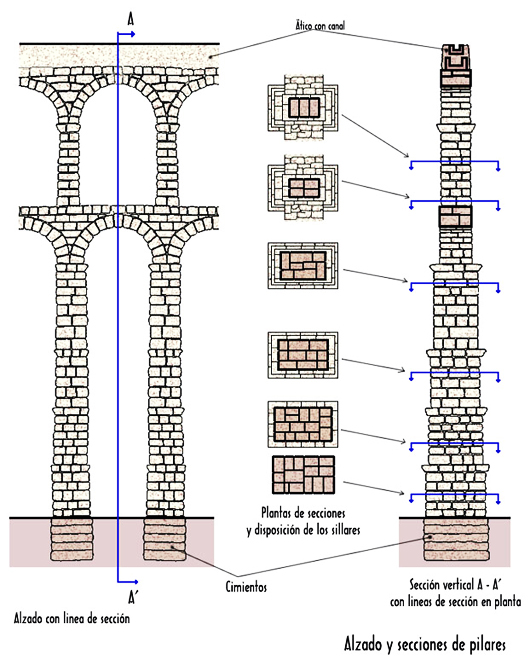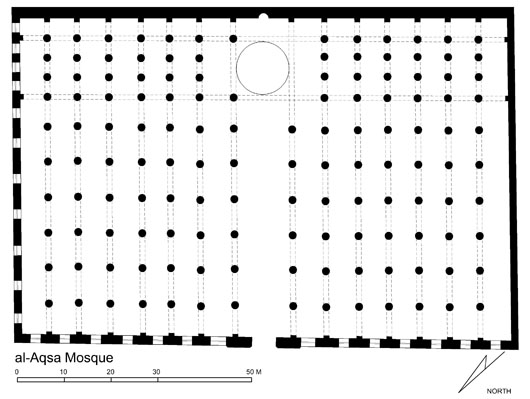The oldest mosques known as the Cufa in Iraq, the arches were parallel to qibla wall of reused columns or pillars of factory and arches very rough. On these arches and horizontal wall screed placed a simple joist of logs and poles on which the wall was growing sideways to hold the thick layer of clay that formed the roof, and had the profile of a bowl with remaining paths at both ends for proper water drainage. The burden of these walls improved the embedment beamed, and protect their heads.
Cufa Mosque, Iraq . Plant early mosque (639)
Cufa Mosque, Iraq . Floor of the mosque h. 670.
Cufa Mosque, Iraq . Volume diagram of the mosque.
This construction system also guaranteed the future growth of the mosque by juxtaposition of parallel aisles to the backyard. From the standpoint of architectural space, the absence of a focal axial nave of the building removed, in contrast to what happened in the Roman tradition of the early Christian basilica.
provision of arcades in a mosque.
Also all "haram", or prayer hall of the mosque, has a equal, where all believers pray in identical vessels in parallel in the direction of Mecca, located around noon (Qiblah). Oratory space emerges as a decoration of panels cut, prefixed to it, as the scenes or decoration of a theater. This formula as basic mosque survived in East ever more refined and finished materials in their ways, for example, when the walls of the courtyard or sahn internally wrapped with a perimeter gallery. The gates are placed on the sides so that from the outside does not see the bottom the sacred wall quibla, or hear the prayer or "khutba" or Koranic explanation. The almemor as chair of preaching there from the home of Muhammad in Medina, and the mihrab indicating the sacred wall is very old. Would be the place of honor on the throne of the Caliph is not sitting, it would have turned their backs to Mecca and knelt before which like other Muslims in equal position.
model mosque, so simple, bankruptcy when it came to building a "Grand Mosque", as in Damascus, of a size, so superior to its previous height and width of aisles, which invalidated the constructive possibilities of a single joist, and forced to consider resource utilization Hellenistic the armor of their classic scissors trusses. By applying the simple expedient raised, came the inevitable requirement to place in the line of support of two trusses, sobe archery, a drainage channel for water, vital in this region of low rainfall.
Great Mosque of Damascus, Syria (705-715) . Plant showing the Umayyad and Roman elements.
Great Mosque of Damascus, Syria (705-715) . Volume scheme.
Great Mosque of Damascus, Syria (705-715) . Interior.
In ancient Rome, the theory of a single or double arches holding a water channel, only existed in aqueduct styled for urban supply. We know of two major types of aqueducts. The superimposed arcades, such as Segovia, and many more, and the later formula built on large unit cells, sometimes with small buttresses side for stability, holding the "specus" or channel of the aqueduct. These batteries are laterally restrained with various orders of bracing arches that do not hold anything, but that prevent the buckling of the batteries.
Aqueduct of Segovia, Spain ( s. II d. C.). Elevation and sections of a section type.
The first type, who knew the Arabs in Damascus Roman aqueduct, which was given its shape, the arches supported by columns reused in the ancient world to the ships of the East Grand Mosque.
Great Mosque of Damascus, Syria (705-715) . Interior elevation of the arches.
The second model, the bracing arches, which was copied as supporting structure of the mosque, the Syrian architects Abd al-Rahman I in Córdoba, when they went to Merida to find old columns for the construction of the mosque, and there found great ideas for the structure drawn the aqueduct called the Miracles of the old Roman capital of the Lusitania.
Aqueduct of the Miracles, Mérida (first century AD) . Volumetric reconstruction.
The roof trusses resolved paths, resting on the edges of the arched aqueduct channel, which has for correct sizing a bit too thick, which is camouflaged with false-work arc that is that really gives visual proportions. This large transverse dimension of the batteries is reduced by paths roll brackets or corbels, Umayyad progeny.
Mosque-Cathedral of Cordoba, Spain (s. VIII-XVI). Elevation and sections of an arcade type.
The upper arch is semicircular, but the bottom is a horseshoe, following the latter's English-Visigoth tradition, probably late Roman, like the alternation of the cove in stone and brick blocks two-color lends unique. The Pillar and the cantilevers loaded onto the cornice, cut Roman architectural moldings, transmitting its capital and stem weight, using as a foundation based itself more or less underground, depending on the total height of the column.
Under the minaret was built and under Abd al-Rahman II was the first ampliación de la mezquita hacia el sur, manteniendo como pilares que marcan la solución de continuidad los contrafuertes de la cabecera.
Mezquita-Catedral de Córdoba, España (s. VIII-XVI) . Planta de las distintas ampliaciones.
Este edificio, tan aparentemente perfecto, tenía un fallo estructural en la fachada al patio, labrada on stone piers insufficient to absorb the thrust of the arches of the ships, so all the headwall turned to the patio. Abd al-Rahman III consolidated facade concealing adding buttresses and roll with a new facade parallel to the original, and well poised outside. He completed his work by enlarging the patio in the same dimension "will" and inside with a gallery surrounding the alternating triple arches on columns, pillars adjacent columns, as in the courtyard of St. Sophia in Constantinople. This forced to build a new minaret which will be discussed somewhat later.
Mosque-Cathedral of Cordoba, Spain (s. VIII-XVI) . Floor of the courtyard of the orange and section through the front door.
More important was the great expansion of Al-Haken II, expressly carved columns, alternating gray and pink marble Corinthian and composite capitals, carved solid simple volumes as capable as Cubist a simplification. Appear ribbed vaults and studied to discuss these architectural elements, and still under Mansur nearly doubled the size of the mosque to the east.
Mosque-Cathedral of Cordoba, Spain (s. VIII-XVI) . Expanding arcades Almanzor.
This wonderful set, influenced by the Latin West, has its naves perpendicular to the qibla, as was the case in the Al-Aqsa mosque in Jerusalem and in the Kairawan. Cordoba model, highly simplified, with simple horseshoe arches, and in most cases three to five ships, often staggered in height, which would would extend the Taifa Spain.
Al-Aqsa Mosque, Jerusalem, Israel (1034-1036) . Perspective.
Al-Aqsa Mosque, Jerusalem, Israel (1034-1036) . Interior.

Mosque of Kairouan, Kairouan, Tunisia (836-875). Plant.
Almoravid and in time come to the West Almohad mosques factory on stilts, the type of Samarra through Ibn Tulun mosque in Cairo. The synthesis occurs in North Africa where there was a prototype that has a ship parallel to the qibla, where they dig other perpendicular frame.
Ibn Tulun Mosque, Cairo, Egypt (876-879). Plant.
arc occurs widely lobes and pointed horseshoe, he was born staking irregularities extending Mansur but now will become a classic, like so many things that emerged at random from the mosque. The Almohad mosque of Seville, inspired by the austerity of these models would be the most important African in the West after the one in Córdoba.
Lecture by D. Rafael Manzano Martos on November 17, 2010 at the School of Architecture at the University of Notre Dame, USA.

























0 comments:
Post a Comment